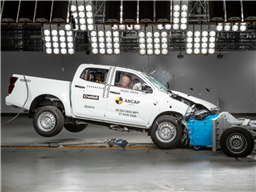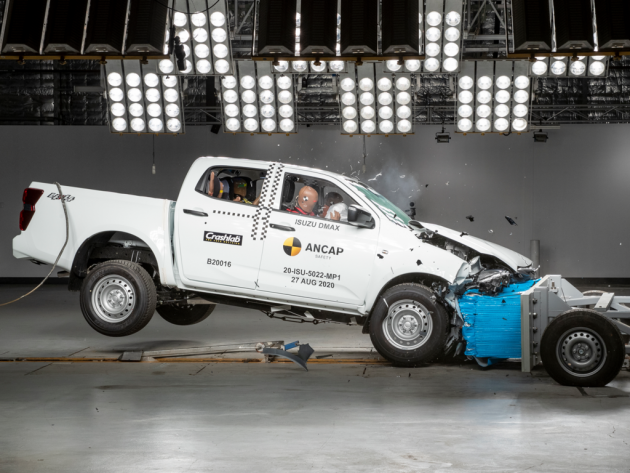The 2021 Isuzu D-Max has scored a five-star rating in the Australasian New Car Assessment Program (ANCAP), and it is the first to be tested through the programme’s stricter criteria. Introduced in Australia and New Zealand this month, the five-star rating attained by the 2021 D-Max is applicable to all variants on sale in those countries, says ANCAP.
In this test, the D-Max scored an adult occupant protection (AOP) score of 83%, a child occupant protection (COP) score of 89% and a vulnerable road user protection score of 69%. Meanwhile, The 2021 D-Max attained a safety assist score of 81%.
In the frontal offset impact test, the passenger compartment of the 2021 D-Max was found to have remained stable, although protection of the driver’s chest and upper legs were rated marginal. Protection for the passenger chest as well as both driver’s and passenger’s lower legs were rated adequate, while protection for all other critical body regions was rated good.
The full-width frontal impact test saw a ‘marginal’ rating for the chest of the rear passenger, while all other critical body regions for driver and rear passenger were rated ‘good’. Full points were awarded to the D-Max in the side impact and oblique pole tests, where the pick-up truck scored a ‘good’ rating in protection for all critical body regions.
Here, the centre airbag was found to have prevented contact between the heads of both front seat occupants in side impacts. Prevention of excursion in the far side tests was rated ‘adequate’ for the vehicle-to-vehicle impact scenario, and ‘marginal’ in the vehicle-to-pole scenario. Overall, the vehicle’s side impact performance was rated ‘adequate’, and a rescue sheet with information for first responders is available for all variants.
For child occupants, the D-Max scored a ‘good’ rating in the frontal and side impact tests for all critical body areas for both six- and 10-year-old child dummies. The crew (dual) cab variant of the D-Max is equipped with lower and upper Isofix anchor points for the rear outboard seats, however the report notes that installation of child restraints for the centre seat is not recommended as there is no top anchor for this position, and similarly not recommended in the single and space cab variants, also for the lack of anchor points.
In terms of vulnerable road user protection, the bonnet of the D-Max was rated ‘marginal’ or ‘adequate’ for protection of a struck pedestrian’s head over most of the bonnet’s surface, while impact protection was rated ‘good’ along the rear of the bonnet.
Pelvic protection saw mixed results, with mostly ‘good’ ratings, and some ‘adequate’ and ‘poor’ results. Meanwhile, the front bumper scored maximum points for the protection of pedestrians’ lower legs, with results rated ‘good’ at all test locations. For autonomous emergency braking (AEB), the system in the D-Max was rated ‘adequate’ in pedestrian test scenarios and ‘marginal’ in cyclist test scenarios.
The AEB system in the D-Max does not detect pedestrians when reversing, the report found. Additionally, the AEB car-to-car assessment found that the system avoided or mitigated collisions in all scenarios. Some speed scenarios also found the system to prevent collisions with oncoming vehicles turning across its path, and the systems in the D-Max scored an overall ‘good’ rating.
Lane support is standard on all 2021 D-Max variants for the Australia and New Zealand markets, where lane keeping assist functionality was rated ‘good’ and emergency lane keeping was rated ‘adequate’. Overall performance of lane support in the 2021 D-Max was rated ‘adequate’. All seat positions get a seatbelt reminder system, and a speed assistance system is standard, and can identify the local speed limit and apply it through the onboard speed limiter. A driver drowsiness detector is also fitted as standard.
The ANCAP tests the 2021 Isuzu D-Max in the Utility category, in which it has scored the aforementioned five-star rating. This third-generation D-Max made its debut in October last year, and has gone on sale in Thailand in the same month. As of January, Isuzu Malaysia stated that the third-generation pick-up won’t be arriving in our country this year, likely owing to the late introduction of the second-generation facelift here.
Source: Read Full Article





